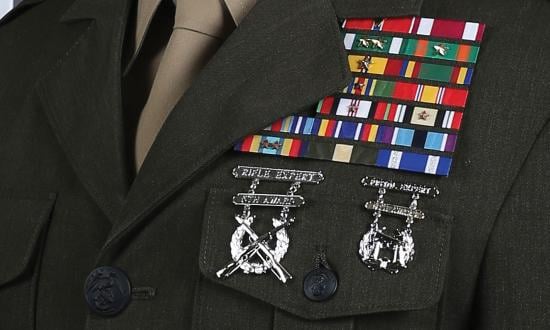I am a leader in the U.S. Navy, and I am unconsciously biased—that is, I subconsciously harbor bias as a result of my societal upbringing and collective life experiences. I do not think or feel I am biased against those who are unlike me, and I am not aware of any actions I have done or words I have written or said that could have been perceived as biased. But this does not remove the fact that I am a member of the dominant group in a society suffering from institutionalized and historically ingrained bias.
I also am not alone in this condition; it affects us all—although its admission is socially unmentionable. Only by acknowledging and educating ourselves on the origin and consequences of unconscious bias can we progress toward its elimination and fulfill the promise of equality.
Response to the Death of George Floyd
Streamed around the world on an unending, tortuous loop, the death of George Floyd left a profound mark on the world’s social conscious. The Department of Defense was not alone in responding, nor was it first. Former Secretary of Defense Mark Esper waited more than a week.
On 2 June, in a memorandum titled “Support to Civil Authorities,” Esper said three things: He supported free speech, he was committed to the rule of law, and service members should remain apolitical.1 Simultaneously, he moved 1,600 active-duty Army troops into the National Capital Region, although in a departure from the President, he kept these troops outside the city.2
Chief of Naval Operations Admiral Mike Gilday on 2 June issued a video acknowledging the murder—a term not all have used—of George Floyd, sympathizing with those questioning what could be done about it, and humbly admitting to being unable to fully understand the experiences of black people. He noted that a policy change would not fix the situation, but proposed that the Navy listen to black Americans, recognize racism in the service, and speak out against racist commentary, even from friends.3
Following these initial statements, a number of changes have been made. On 18 June 2020, Esper acknowledged that bias exists in the military and affirmed that the military “embraces diversity and inclusion, and rejects hate, bigotry, and unlawful discrimination in all forms.”4 He announced three initiatives: (1) an internal Defense Board on Diversity and Inclusion aimed at increasing diversity and ensuring equal opportunity; (2) an external Defense Advisory Committee on Diversity and Inclusion in the Armed Services for guidance on these issues; and (3) direction to Pentagon leaders to provide ideas for immediate implementation.On 25 June, Admiral Gilday shared personal experiences from sailors and encouraged dialogue about race relations and inclusion within the Navy at each command.5
Beginning 14 July, Esper issued guidance related to promotion and selection boards changes, equal opportunity and diversity and inclusion policies, data analysis on retention and promotion, training on bias awareness, a program to enable organizational discussion, grooming policies, and equal opportunity office effectiveness, as well as periodic reports on the implementation and progress of these actions.6 On 16 July, he announced a revised policy on display of the American and representational flags, the key takeaway being removal of the Confederate flag.7
These are not insignificant changes, and it is too early to tell how effective any of them may be. Some surely sound familiar to current and former service members. Especially promising, however, are the addition of bias awareness training, requirements to educate the force on unconscious bias with “clear and concise definitions of key and relevant terms,” and scenario-based training and talking points to help guide unit and organizational discussions on discrimination, prejudice, and bias.8
Education Is Key
The military must begin educating its people on bias awareness. There is a wealth of scholarship on the topic and an entire vocabulary that unfortunately remains a foreign language to most sailors, Marines, soldiers, and airmen, as well as to their leaders. The average service member does not have an understanding of commonly used terminology such as code-switching, white privilege, white fragility, and microaggressions.
While everyone has an obligation to educate themselves on these subjects, the Navy cannot fault its people for what they do not know. It is a leader’s duty to provide ongoing, quality education to combat the problems of bias in the ranks. Hopefully, that education will start with the initiatives currently under way, but the fruits of those labors could be months if not years away. We cannot afford to wait to begin knowledgeably discussing bias in the workplace. Mere direction to share experiences and talk about race relations at the unit level—with no formalized goals or underlying scholarly research—will be no more than an ineffective, momentary glance at deep-seated injustice.
So what should leaders do, and perhaps also not do? Fear of misspeaking or being misunderstood leads to paralytic inaction. Fortunately, there are some answers out there. First, below are a few definitions, followed by suggested “Do” and “Don’t” lists.
Code switching is “adjusting one’s style of speech, appearance, behavior, and expression in ways that will optimize the comfort of others in exchange for fair treatment, quality service, and employment opportunities.”9 While this can increase perceptions of professionalism and similarity with dominant groups, it also can lead to resentment from one’s racial group. Avoiding stereotypes on two fronts both strains and negatively affects performance and diminishes genuine self-expression.
White privilege is “not the suggestion that white people have never struggled” and “not the assumption that everything a white person has accomplished is unearned.” Rather, it means “having greater access to power and resources than people of color in the same situation,” or somewhat of a “built-in advantage.”10 This manifests in a broad range of contexts, ranging from consumer products sold as normal (e.g., the skin tone of Band-Aids), to interactions with law enforcement, creditors, and judges and juries.
White fragility is “weaponized defensiveness” by white people at the notion that being white has inherent advantages or when their assumptions about race and racism are questioned, resulting in difficulty for people of color to talk about unconscious racist comments or behaviors.11 It sometimes manifests as a defensive tendency to search for evidence about what victims do to deserve abuse rather than demonstrating compassion and empathy (e.g., diminishing protestors by focusing on those engaged in looting instead of discussing the unjust act that drove people to the streets).
Microaggressions are “behaviors or statements that do not necessarily reflect malicious intent but which nevertheless can inflict insult or injury.”12
Do
• Acknowledge racism.13
• Affirm minority rights.
• Offer a space to share.
• Make it clear you care.
• Identify harm without being defensive.
• Embrace conflict and deal with discomfort.
• Be accountable and track and monitor progress.
• Recognize that many minorities conform (“code-switch”) to comfort white people and deal with racialized aggressions and microaggressions.
• Evaluate bias competency—ability to identify racism, comfort levels in critical conversations, and leadership engagement.
• Engage with minority colleagues in casual settings.
• Establish, participate in, and provide funding for service member resource groups focusing on minorities, as they help develop leaders, lead to higher retention rates, educate service members and leaders, and help with diverse recruiting.
• Ask black service members about their work, goals, and concerns, and how you can help.
• Provide black colleagues with visible opportunities, volunteer feedback on their work, make professional introductions, publicly recognize their accomplishments, reward the additional work involved with diversity education and mentoring, and share their experiences.
• Be aware that some questions or topics might trigger deeply held emotions that must be allowed and respected.
• Educate yourself and commit to continued learning on issues affecting all minorities.
• Admit mistakes and blind spots and apologize.
• Express thanks when someone corrects you.
Don’t
• Keep silent.
• Sidestep or avoid difficult conversations.
• Become paralyzed by fear into inaction.
• Become defensive.
• Overgeneralize and speak for others or engage in colorblind communications (e.g., “We’re all in this together”).
• Rely on racial minorities to educate you or comfort and advocate for other minorities.
• Control the conversation or speak over persons of color.
• React with denial about personal stories of bullying, harassment, and trauma.
• Normalize white experiences at the expense of others’ experiences.
• Focus on a person’s racial background, personal life, or physical appearance.
Facing the problems of discriminatory bias, the easy answers are to make antiracism proclamations and prohibitions against overt discrimination. This has been the modus operandi for too long. To leap forward toward equality, we must be willing to admit that bias exists and that its roots run deep, not merely in the blatant examples we can see and hear. Continuing education is necessary. We may never fully root out racism and other forms of discrimination, but to respect our fellow human beings, we must try.
1. Secretary of Defense Mark T. Esper, “Message to the Department – Support to Civil Authorities,” 2 June 2020.
2. Assistant to the Secretary of Defense for Public Affairs Jonathan Rath Hoffman, “Statement on Support to Civil Authorities,” 2 June 2020.
3. ADM Michael Gilday, USN, “CNO Message to Sailors,” 3 June 2020.
4. Secretary of Defense Mark T. Esper, “Message to the Force on DOD Diversity and Inclusiveness,” 18 June 2020.
5. ADM Michael Gilday, USN, “One Team, One Navy,” 25 June 2020.
6. Secretary of Defense Mark T. Esper, “Immediate Actions to Address Diversity, Inclusion, and Equal Opportunity in the Military Services,” 14 July 2020.
7. Secretary of Defense Mark T. Esper, “Public Display or Depiction of Flags in the Department of Defense,” 16 July 2020.
8. Esper, “Immediate Actions to Address Diversity, Inclusion, and Equal Opportunity.”
9. Courtney L. McCluney et al., “The Costs of Code-Switching,” Harvard Business Review, 15 November 2019.
10. Cory Collins, “What is White Privilege, Really?” Teaching Tolerance, no. 60, (Fall 2018).
11. Robin DiAngelo, “What’s My Complicity? Talking White Fragility With Robin DiAngelo,” Teaching Tolerance, no. 62 (Summer 2019).
12. Simba Runyowa, “Microaggressions Matter: They May Not Always Be Ill-Intentioned, But the Slights Illuminate Deeper Problems in America,” The Atlantic, 18 September 2015.
13. This “Do” and “Don’t” lists were compiled from the following sources: Laura Morgan Roberts and Ella F. Washington, “U.S. Businesses Must Take Meaningful Action Against Racism,” Harvard Business Review, 1 June 2020; Laura Morgan Roberts et al., “How U.S. Companies Can Support Employees of Color Through the Pandemic,” Harvard Business Review, 22 May 2020; Kira Hudson Banks and Richard Harvey, “Is Your Company Actually Fighting Racism, or Just Talking About It?” Harvard Business Review, 11 June 2020; Tsedale M. Melaku and Angie Beeman, “Academia Isn’t a Safe Haven for Conversations About Race and Racism,” Harvard Business Review, 25 June 2020; Ben Hecht, “Moving Beyond Diversity Toward Racial Equity,” Harvard Business Review, 16 June 2020; Stephanie Creary, “How to Be a Better Ally to Your Black Colleagues,” Harvard Business Review, 8 July 2020; Aiko Bethea, “What Black Employee Resource Groups Need Right Now,” Harvard Business Review, 29 June 2020; and Daisy Auger-Dominguez, “Getting Over Your Fear of Talking About Diversity,” Harvard Business Review, 8 November 2019.






